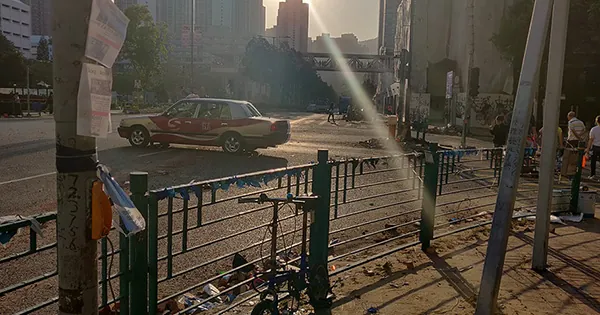
Explore the Controversy Behind Hong Kong's National Security Exhibition
2025-01-14
Author: Ying
Introduction
The Hong Kong Museum of History has launched a provocative National Security Exhibition Gallery that sheds light on the contentious National Security Law implemented in 2020. This permanent exhibit, overseen by the Committee for Safeguarding National Security—an entity under the direct supervision of the Chinese government—aims to present an official narrative surrounding recent historical events in the region.
Thematic Overview
Upon entering the gallery, visitors are met with a short video montage that includes archival footage of Chairman Mao Zedong from the 1949 founding of the People’s Republic of China (PRC). This montage sets the stage for the exhibit's overarching theme: the 1997 'return' of Hong Kong to China and the alleged external interference that fueled the pro-democracy protests in 2019—events the exhibit characterizes as a 'color revolution.'
The messaging throughout the gallery is emphatic. One plaque boldly proclaims, 'National security brings security to Hong Kong, our families, and the people.' It showcases a narrative steeped in the historical significance of the Chinese Communist Party (CCP) while underscoring its self-ascribed role as the protector of national security.
Broader Implications
Interestingly, while there is a mention of the national security issues specifically faced by Hong Kong, the exhibit extends its focus to encompass Beijing's broader objectives. It draws connections between cultural, technological, financial, and even ecological security, suggesting that these aspects are interlinked and vital to the Party's national security strategy under Xi Jinping's leadership.
National Security Narrative
The significance of the term ‘national security’ echoes throughout the exhibit, often described as 'the bedrock of national rejuvenation,' a phrase frequently used by Xi Jinping in relation to the Chinese Dream—an aspiration for the country to regain its historical glory. The CCP's portrayal of national security as a fatherly duty aimed at protecting families is a strategic effort to garner public trust, enabling societal acceptance of heavy censorship and the infamous 'Great Firewall.'
Exhibition's Target Audience
Notably, the exhibit caters primarily to a domestic audience, with the majority of texts in Mandarin, requiring visitors seeking English translations to utilize QR codes. School groups depicted strolling through the gallery highlight the pro-government educational outreach.
Historical Validation
The narrative continues with a focus on archaeological findings purported to validate China's claims over contested territories like the South China Sea. A plaque boasts that discoveries of ancient relics substantiate the CCP’s posture on sovereignty, showcasing how cultural heritage is enlisted as a tool for political aims.
Protests and Foreign Interference
Another influence of the exhibition is its reflection on the Hong Kong protests, depicted as destabilizing forces led by foreign interference. The exhibit's rhetoric portrays these historical events as threats to national security akin to other suspected externally instigated uprisings worldwide.
Espionage Concerns
A particularly striking section discusses espionage, asserting that local figures are vulnerable to manipulation by foreign intelligence services. It leverages high-profile quotes from US intelligence officials, promoting an image of a nation on guard against pervasive external threats.
Informative Warning
Perhaps most alarmingly, the exhibit serves as both an informative and ominous warning. A comprehensive overview of the Hong Kong National Security Law outlines severe penalties for offenses ranging from secession to subversion, starkly reinforcing the potential consequences of dissent.
Conclusion
In the end, the exhibit delves beyond Hong Kong, covering myriad security interests that Beijing perceives as vital to its future—from ecological to technological security. One particularly notable section highlights China's ambitions in polar regions, underscoring its aspirations to project power and influence globally.
While the gallery may be a source of unease for tourists and foreign visitors—who might interpret its narrative as totalitarian—its primary objective is undeniably cautionary, aimed squarely at the Hong Kong populace. As the world watches the ongoing evolution of Hong Kong's identity under the shadow of the National Security Law, the implications for personal freedoms and national sovereignty remain a crucial discussion point.


 Brasil (PT)
Brasil (PT)
 Canada (EN)
Canada (EN)
 Chile (ES)
Chile (ES)
 Česko (CS)
Česko (CS)
 대한민국 (KO)
대한민국 (KO)
 España (ES)
España (ES)
 France (FR)
France (FR)
 Hong Kong (EN)
Hong Kong (EN)
 Italia (IT)
Italia (IT)
 日本 (JA)
日本 (JA)
 Magyarország (HU)
Magyarország (HU)
 Norge (NO)
Norge (NO)
 Polska (PL)
Polska (PL)
 Schweiz (DE)
Schweiz (DE)
 Singapore (EN)
Singapore (EN)
 Sverige (SV)
Sverige (SV)
 Suomi (FI)
Suomi (FI)
 Türkiye (TR)
Türkiye (TR)
 الإمارات العربية المتحدة (AR)
الإمارات العربية المتحدة (AR)